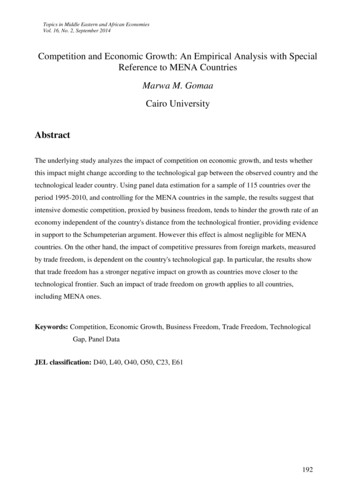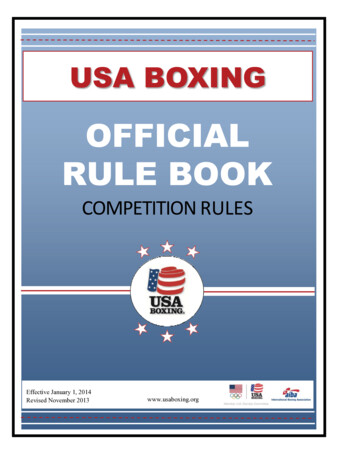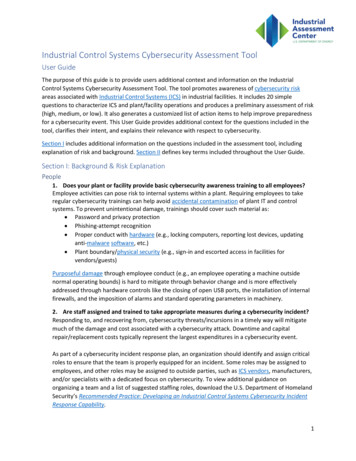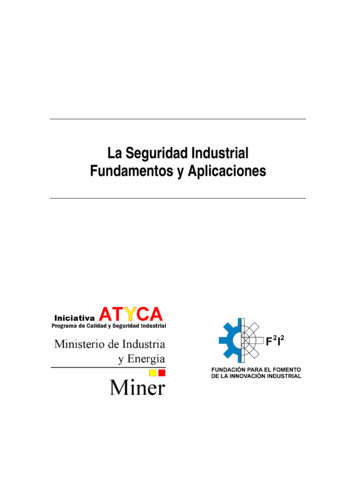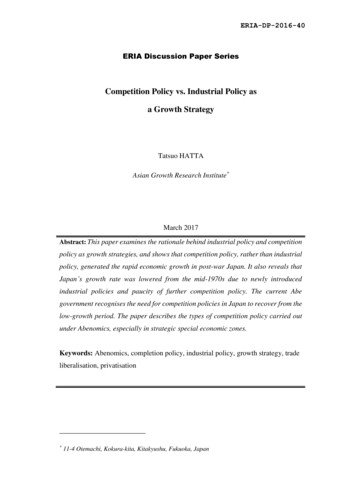
Transcription
ERIA-DP-2016-40ERIA Discussion Paper SeriesCompetition Policy vs. Industrial Policy asa Growth StrategyTatsuo HATTAAsian Growth Research Institute*March 2017Abstract: This paper examines the rationale behind industrial policy and competitionpolicy as growth strategies, and shows that competition policy, rather than industrialpolicy, generated the rapid economic growth in post-war Japan. It also reveals thatJapan’s growth rate was lowered from the mid-1970s due to newly introducedindustrial policies and paucity of further competition policy. The current Abegovernment recognises the need for competition policies in Japan to recover from thelow-growth period. The paper describes the types of competition policy carried outunder Abenomics, especially in strategic special economic zones.Keywords: Abenomics, completion policy, industrial policy, growth strategy, tradeliberalisation, privatisation*11-4 Otemachi, Kokura-kita, Kitakyushu, Fukuoka, Japan
It has often been argued that the source of Japan’s rapid post-war growth was theindustrial policies of the Ministry of Economy, Trade and Industry (METI).1 In recentyears, competition policies have been widely recognised as essential for the recoveryof growth in Japan. 2 In this paper, we compare industrial policy with competitionpolicy as a strategic instrument for promoting economic growth in the context ofJapan’s post-war economic growth.Industrial policy promotes targeted industries selected by the government throughtrade protection, tax breaks, and government loans. Competition policy, on the otherhand, refers to any policy that promotes competition in the market. It includesderegulation, trade liberalisation, anti-cartel policy, and the privatisation of publiclyowned monopolies.In this paper, we examine the rationale behind industrial policy and competitionpolicy as growth strategies, and we show that competition policy, rather than industrialpolicy, generated the rapid economic growth in post-war Japan. We will also revealthat Japan’s growth rate was lowered from the mid-1970s due to newly introducedindustrial policies and paucity of further competition policy. The current Abegovernment recognises the need for competition policies in Japan to recover from thelow-growth period. We describe what types of competition policy have been carriedout under Abenomics, especially in strategic special economic zones.In Part 1, we compare competition policy and industrial policy as a growthstrategy. In Part 2, we examine various justifications for industrial policies andconclude that none of the conventional justifications for industrial policies are wellfounded in practice. Then we cite a number of empirical studies that confirm theindustrial policies were not effective in Japan. In Part 3, we demonstrate that the seriesof competition policies in the early post-war period laid the groundwork for theeconomic growth of the 1960s. In Part 4, we examine why Japan stopped growing inthe mid-1970s. We conclude that this was due to a slowdown in competition policy,which was not politically popular. We also review recent attempts to revitalisecompetition policy in Japan, especially under the Koizumi reform and the recent Abe1 See,2 See,for example, Johnson (1982).for example, Botman, Danninger, and Schiff (2015).1
reform. We outline the current status of these reforms and difficulties they have faced.In Part 5, we point out the most urgent growth agenda that Japan has faced is reformof employment regulations. The conclusion reiterates why competition policy, whichis politically difficult, plays a crucial role as a growth strategy. The appendix outlinesthe system of national strategic special zones under the Abe government.1. Growth Strategy1.1. Two Sources of Economic GrowthIn designing a growth strategy, it is useful to distinguish between two sources ofeconomic growth:The first is, of course, innovation.The second is shifting resources from lowproductivity sectors to high-productivity sectors. For example, migration of workersfrom agricultural to the manufacturing sectors improved nation’s productivity duringthe rapid growth period.Industrial policy is typically intended to foster innovation in targeted industries.Competition policy is designed to shift resources to high-productivity sectors. Toimplement competition policy, the government does not select targeted industries.Rather, the market is given the role of selecting the industries that grow.1.2. Why Competition Policy?Microeconomics tells us that competitive markets allocate resources efficiently inthe absence of market failure. This proposition, which is called the ‘basic theorem ofwelfare economics’, is the basis of any competition policy.In the absence of market failure, market competition ensures that resources flowin the direction of higher productivity in search of higher rewards. Hence, marketsallocate resources efficiently.However, this natural flow of resources often faces obstacles set up by incumbentfirms to protect their vested interests. Competition policy is designed to remove theseobstacles that hamper the natural flow of resources.A noteworthy example of competition policy that removes the obstacles to freemovement of resources is the tariff-free opening of Japanese ports in 1859, which was2
forced on Japan by the foreign powers. This wiped out Japan’s domestic cottongrowing industry within 10 years. The high growth of the early Meiji period would nothave been possible without such a drastic competition policy.1.3. Why Industrial Policy?Industrial policy is nothing but a market intervention. In view of the basic theoremof welfare economics, it is justifiable to the extent that market failure exists. Suchfailure could arise from scale economies, public goods, externalities, and informationalasymmetries (Rosen and Gayer, 2014).2. Industrial Policy2.1. Justifications for Industrial PolicyLet us now examine whether any of the market failures can justify industrialpolicies.Scale EconomiesThe first example of industrial policy is the ‘infant industry argument’, whichstates that an industry subject to scale economies may be protected in its initial stages,through import tariffs, for example.However, if capital markets are perfect, private investors will find it profitable toinvest in such industries anyway. In this case, government intervention is unnecessary(Krugman, Obstfeld, and Melitz, 2015).In particular, given perfect international capital mobility, foreign companies willbe attracted to invest in such an industry. Thus, the traditional justification forindustrial policy based on the presence of scale economies is untenable in thecontemporary environment of global capital movement.ExternalitiesThe second justification is based on the existence of externalities. However, if thesource of externalities is the spillover effect of technological innovation, theappropriate policy is to establish a system for protecting intellectual property rights. Ifexternalities are caused by agglomeration-type externalities, it is appropriate toprovide Pigouvian subsidies for the activities that produce externalities rather than3
export subsidies, for example (Rosen and Gayer, 2014; Krugman, Obstfeld, andMelitz, 2015).Strategic Trade PolicyThe third justification is based on Krugman’s strategic trade policy (1986), whichis essentially a ‘beggar-thy-neighbour’ policy. Krugman (1987) points out that by itsnature, this policy may be difficult to sustain in the long run. Thus, strategic tradepolicy is impractical.We therefore conclude that none of the conventional justifications of industrialpolicy are well founded in practice.2.2. Industrial PoliciesThroughout the post-war period, the Government of Japan intervened in themarket to promote growth of some industries and to prevent decline of other industries.We may roughly divide this period into two periods: the rapid growth period untilthe oil shock of 1973 and the low growth period after that (Komiya, Okuno, andSuzumura, 1988).In the first period, the Japanese government promoted various heavy industrieslike steel and the petrochemical industries. The government also allowed ‘recessioncartels’ into industries like steel and shipbuilding by exempting them from theAntimonopoly Act for a certain period.In the second period, the government shifted the target industries to the computerindustry. It also started to subsidise the declining industries such as agriculture,mining, textile, and shipbuilding, under ‘structural adjustment’, exemplified by theLaw on Temporary Measures for the Structural Improvement of Specified Industries(1983).2.3. Failure of Industrial Policies in JapanUntil around 1980, a common belief was that the source of Japanese economicgrowth was the industrial policy orchestrated by the Japanese Ministry of InternationalTrade and Industry (MITI), as promulgated by Johnson’s book MITI and the JapaneseMiracle (1982).4
However, most of MITI’s industrial policies were ineffective in stimulatinggrowth. In a comprehensive study of industrial policy, Beason and Weinstein (1996)examined all industries and, contrary to the conventional wisdom, found no evidencethat industrial policy measures enhanced productivity.Moreover, Ohashi (2005) demonstrated that subsidising steel exports, a majorplank of MITI’s industrial policy, had an ‘insignificant impact on the growth of thesteel industry’. Export subsidies were not the source of the emergence of the Japanesesteel industry.2.4. Industrial Policy for Declining IndustriesDespite its ineffectiveness, industrial policy has attracted policymakers. Forexample, Beason and Weinstein (1996) found that Japanese industrial policydisproportionately targeted low-growth sectors and sectors with decreasing returns toscale.In addition, Noland and Pack (2003) showed that Japanese industrial policyfocused mainly on agriculture and mining, which are not exposed to internationalcompetition.2.5. Growth without Government HelpThe post-war Japanese experience confirmed the theoretical expectation thatindustrial policy is ineffective: it is difficult to name any successful industries thatreceived help from the government. 3 In fact, companies such as Sony, Honda, andPanasonic grew in the post-war period despite receiving only little help from thegovernment.Indeed, Takeuchi (2002) showed that the government played a negligible role inJapan’s post-war industrial success. His list of industries that thrived in the absence ofgovernment help includes industrial robots, air conditioners, sewing machines,videotape recorders, fax machines, audio equipment, car stereos, typewriters, cameras,carbon textiles, rail tracks, computer games, musical instruments, and forklifts.3Other supporting evidence can be found in Okita (2010) and Miwa and Ramseyer (2006).5
By shifting resources to targeted industries, industrial policy reduces output levelsin untargeted industries. Japan’s industrial policy hampered its economic growth.The damage was exacerbated by choosing industrial policy targets on political,rather than economic grounds (Okita, 2010).3. Competition Policy3.1. Competition Policies in the Early Post-war PeriodCompetition policy played an important role in stimulating Japan’s post-wareconomic growth. Let us review the history of competition policies implementedduring this period.4Dissolution of the Zaibatsu (1945–1950)Immediately after the Second World War, the General Headquarters of theoccupation force, which was then called the GHQ, requested the Japanese governmentto dissolve the pre-war industrial conglomerates known as the zaibatsu. Thedissolution of the zaibatsu took place between 1945 and 1950.Before the war, a small number of conglomerates, including Mitsui,Mitsubishi, and Sumitomo, dominated the Japanese economy. GHQ felt that theseconglomerates had been a driver of the nationalistic, expansionary governmentpolicies that led to the war. GHQ wanted these pre-war conglomerates to bedismantled, partly because of this perception and partly because of its well-foundedbelief that promoting competition would provide an essential environment for ahealthy economy in Japan, as it had in the United States. As a result, the zaibatsucompanies were broken up into several smaller companies, and the shares of theholding companies owned by the zaibatsu families were effectively confiscated.Establishment of the Fair Trade Commission (1947)In 1947, the Japanese government introduced the Antimonopoly Act andestablished the Fair Trade Commission. Following the breakup of the pre-warconglomerates, the various sibling companies managed to maintain informalassociations between themselves. However, they were no longer governed by a single4Ito (1992) gives a good survey of the post-war economic growth of Japan.6
holding company, and these informal groupings were strictly regulated by the FairTrade Commission. The antitrust policy, initially forced upon Japan by GHQ,undoubtedly laid the foundation for the competitive business environmentunderpinning Japan’s post-war economic growth.A symbolic outcome of this policy was the merger of the former Mitsui Bankand the former Sumitomo Bank into the Mitsui-Sumitomo Bank in 1996. It isparticularly interesting to note that this took place while a number of Mitsui andSumitomo group companies were competing against each other, as exemplified by thecompetition between their respective real estate companies or chemical companies.3.2. Competition Policies during the 1960sTrade Liberalisation (1960s–Present)The next major competition policy was the drastic trade liberalisation policy ofthe 1960s, which forced Japanese firms to face international competition.A striking example is the liberalisation of oil imports. By 1960, Japan was almostself-sufficient in coal. However, when the late 1950s brought the availability of cheapMiddle East oil, the Japanese government relied on oil import barriers to protect itsdomestic coal industry.In the early 1960s, the Japanese government’s liberalisation of oil importseffectively dismantled the coal industry, compelling some 200,000 workers to losejobs in this industry (Shimazaki, 2013). However, the rapid economic growth of the1960s would have been impossible without the liberalisation of oil imports (Figure 1).Thus, competition policy was essential in bringing about Japan’s post-wareconomic growth.7
Figure 1. Coal Production and Oil ImportsSource: Japan Coal Energy Center, Ministry of Economy, Trade and Industry.4. Political Economy of Competition Policy and Industrial Policy4.1. Why Did Japan Stop Growing in the Early 1970s?It is natural to ask why Japan stopped growing in the early 1970s. The answer isthat politicians and bureaucrats, who found industrial policy extremely tempting, hadbeen introducing new entry barriers and new industrial policies since the mid-1960s.They strengthened such barriers in the agriculture, medical, and distribution industries.For example, acreage reduction of the rice field was introduced in 1970, new medicalschools have not been allowed since 1972, and the Large-Scale Retail Stores LocationLaw was introduced in 1975. Politicians and bureaucrats also reallocated governmentbudgets from metropolitan areas to rural areas to protect the declining rural areas,thereby artificially reducing migration from the rural to the metropolitan areas.By the end of the 1960s’ period of rapid growth, various industries hadaccumulated vested interests, which they protected by using their influence onpoliticians and government officials to block new entrants.8
Policymakers have been reluctant to conduct competition policies because theychallenge the interests of incumbents whose political power exceeds that of consumers.Thus, Japanese policymakers have been unable to remove entry barriers in agriculture,fisheries, and the health sector. For example, corporations are not allowed to ownfarmland or to operate independent fisheries along the coast. Also, an import tariff of778% is imposed on rice. In addition, numbers of hospital beds are strictly controlledin each city to protect the interests of its doctors.The dramatic decline in Japan’s economic growth rate over the last 40 years wasbrought about by scarcity of new competition policies, and the accumulation of theseentry barriers created by new industrial policies.4.2. Hopeful Signs: Efforts to Rebuild a Competitive EnvironmentThere have been sporadic attempts to strengthen competition.Privatisation of Public Utilities by Nakasone (1980s)Influenced by President Reagan and Prime Minister Thatcher, the Nakasoneadministration privatised the Japan National Railways (1987), Nippon Telegraph andTelephone Corporation (1984), Japan Tobacco and Salt Public Corporation (1985),and Japan Airlines (1987).Regulatory Reform by Koizumi (early 2000s)A more recent example is the series of regulatory reforms implemented by theKoizumi government in the early 2000s.By the end of the 20th century, various industries had accumulated vested interestsand started to defend their interests by setting regulations to block new entrantsthrough their influence on politicians and government officials. The purpose of theKoizumi deregulation was to remove such entry barriers.In particular, revision of the Antimonopoly Act in 2005 introduced amnestymeasures that drastically reduced bid-rigging among major construction companies onpublic projects.4.3. AbenomicsPrime Minister Abe, who regained power in 2013, introduced regulatory reformsin the form of the third of the Three Arrow of Abenomics: the first being monetary9
expansion policy, the second fiscal expansion policy, and the third a so-called ‘growthstrategy through competition policies’. Commenting on the third arrow in Davos in2014, Abe said ‘I’m willing to break through the solid rocks of vested interests overthe next 2 years’.In the subsequent 2 years, Abe introduced a number of competition policies,including the following:(1) FullliberalisationoftheelectricitymarketIn the late 1990s, power transmission was opened up to high-voltage usersunder the third-party access scheme, which imposes penalties on imbalancescreated by non-utility suppliers. This scheme lasted until March 2016.However, in April 2016, coverage of the liberalised sectors was expanded toinclude the household sector and an imbalance settlement scheme wasintroduced, under which imbalances could be bought and sold at the marketprice.(2) The removal of special legal status of the Japan Agricultural Cooperative (JA,Noh-kyoh), which functioned as a political machine to coax protection policiesfrom the government(3) The various accomplishments made in the so-called National Strategic SpecialZones, which has been the centrepiece of the Abenomics growth strategy Corporations can now own agricultural land. New medical school has been established. Homestay businesses have been legalised despite opposition from thehotel sector.5. Agenda for Further Competition PolicyWhat is the competition policy most needed to spur growth in Japan? Of all itsentry barriers, those in the labour market have damaged the Japanese economy themost. Japanese employment regulations effectively oblige companies to keep their‘regular’ employees until retirement age (Ouchi, 2013, Chapters 1 and 3). This makesit difficult for companies to dismiss ‘regular’ employees.10
Under this regulation, it is risky for a company to hire a mid-career person evenwith useful experience for a particular role as a ‘regular’ worker because the companywould be obliged to keep that worker even after he or she is no longer needed. To copewith unexpected changes in the corporate environment, most companies are compelledto hire young persons with good general aptitude and flexibility. Because of theseemployment regulations, companies have a strong incentive to hire school leavers,with a seniority-based wage scale, rather than experienced mid-level career employees(Ouchi and Kawaguchi, 2014, Chapter 5).These regulations make it hard for regular workers to switch employers. First,because dismissals are rare, vacancies for mid-level career positions rarely arise.Second, even when such vacancies do come about, companies typically fill them bypromoting internally. Employing someone mid-career implies that the promotion ofall the regular workers under the seniority of this outsider has to be postpones.These regulations prevent ‘non-regular’ workers from getting regular jobs.5 Thesemake the Japanese labour market inflexible by hindering workers from switchingemployers. Moreover, strict employment regulations hinder people from quitting largecompanies to start new ventures because quitters who fail have nowhere to go back.This may explain why relatively few venture companies emerged in Japan’sinformation technology industry. This contrasts with the case of Taiwan, for example,where there were successful collaborations with Silicon Valley firms in the 1980s.6. Conclusion: More Competition Policy for Growth6.1. Choice of Growth IndustriesIndustries are targeted for growth differently under industrial policies andcompetition policy. The industries targeted by industrial policies are often selected forpolitical reasons. If the policies fail, no one in government takes financialresponsibility. By contrast, the industries that grow under competition policy areselected based on competition in the market. If these industries fail, investors in thesegrowing industries take full responsibility.5Companies can hire non-regular employees as such at most 5 years.11
6.2. Political Popularity of Industrial PolicyDespite its ineffectiveness, industrial policy has been favoured by policymakers.This bias has led to their misguided use in Japan.Why do policymakers favour industrial policy? The answer is that thebeneficiaries of industrial policies campaign for them more vigorously than theiropponents campaign against them.Because industrial policy heavily benefits a relatively small number of firms, thebeneficiaries of such policies have a strong political incentive to campaign for theirimplementation. This tempts government officials and politicians to receive eitherexplicit or implicit kickbacks from the assisted industries6. In Japan, many high-levelgovernment officials retire to take up executive positions with firms that have beentargeted by industrial policies. For example, two presidents and six vice presidents ofthe major steel company in Japan were former vice ministers of METI between 1980and 1989.Because the negative effects of industrial policy are thinly spread acrossconsumers in the form of slightly higher prices or tax rates, the victims of industrialpolicy do not find it worth campaigning against them (Krugman, Obstfeld, and Melitz,2015).This is why industrial policies are popular among politicians and bureaucratsdespite their ineffectiveness7.6.3. More Competition Policy for GrowthSome representative post-war Japanese firms started as venture companies in acompetitive environment. For example, Sony was founded in 1946 by two youngengineers, Masaru Ibuka and Akio Morita. Honda Motor was founded by SoichiroHonda, who was not a college graduate. Panasonic was founded by KōnosukeMatsushita, who did not even go to junior high school. These success stories in theearly post-war period indicate the importance of the competitive environmentsymbolised by the zaibatsu dissolution, anti-monopoly policy, and trade liberalisation.67See Olson (1965) and Stigler (1971)See Stigler (1975) for a further discussion on this point.12
Whether Japan can regain its strength depends on how vigorously it can continueto implement competition policy.ReferencesBeason, R., and D.E. Weinstein (1996), ‘Growth, Economies of Scale, and Targetingin Japan (1955–1990)’, The Review of Economics and Statistics, 78(2), pp.286–295. http://doi.org/10.2307/2109930Botman, D., S. Danninger, and J. Schiff (2015), Can Abenomics Succeed? Overcomingthe Legacy of Japan’s Lost Decades. Washington, DC: International MonetaryFund.Ito, T. (1992), The Japanese Economy. Cambridge, MA: MIT Press.Johnson, C.A. (1982), MITI and the Japanese Miracle: The Growth of IndustrialPolicy, 1925–1975. Redwood City, CA: Stanford University PressKomiya, R., M. Okuno, and K. Suzumura (eds.) (1988), Industrial Policy of Japan.Cambridge, MA: Academic Press.Krugman, P.R. (1986), Strategic Trade Policy and the New International Economics.Cambridge, MA: MIT Press.Krugman, P.R. (1987), ‘Is Free Trade Passé?’, Journal of Economic Perspectives, 1(2),pp. 131–144. doi:10.1257/jep.1.2.131Krugman, P.R., M. Obstfeld, and M. Melitz (2015), International Economics: Theoryand Policy (10th edition). New York, NY: Pearson Education.Miwa, Y., and J.M. Ramseyer (2006), The Fable of the Keiretsu: Urban Legends ofthe Japanese Economy, Chicago, IL: University of Chicago Press.Noland, M., and H. Pack (2003), Industrial Policy in an Era of Globalization: Lessonsfrom Asia. Washington, DC: Peterson Institute for International Economics.Ohashi, H. (2005), ‘Learning by Doing, Export Subsidies, and Industry Growth:Japanese Steel in the 1950s and 1960s’, Journal of International Economics,66(2), pp. 297–323. doi:10.1016/j.jinteco.2004.06.008Okita, Y. (2010), The Post-War Japanese Economy (Sengo Nihon Keizai-ron). Tokyo,Japan: Toyo Keizai Inc.Olson Jr, M. (1965), The Logic of Collective Action: Public Goods and the Theory ofGroups. Cambridge, MA: Harvard University Press.Ouchi, S. (2013), Employment Reformation (Koyou Kaikaku). Tokyo, Japan: ChuoKeizaisha.Ouchi, S., and D. Kawaguchi (2014), Understanding the World of Employment: APerspective from Law and Economics (Hou to Keizai de Yomitoku Koyou noSekai). Tokyo, Japan: Yuhikaku Publishing.13
Rosen, H.S., and T. Gayer (2014), Public Finance (10th edition). New York, NY:McGraw-Hill Education.Shimazaki, N. [2013]. Employment Measures for Displaced Workers in the DecliningCoal Industry. The Japanese Journal of Labour Studies, 55(12). 4-14. Tokyo,Japan: The Japan Institute for Labour Policy and Training.Stigler, G.J. (1971), ‘The Theory of Economic Regulation’, Bell Journal of Economicsand Management Science, 2(1), pp. 3–21. doi: 10.2307/3003160Stigler, G.J. (1975), The Citizen and the State: Essays on Regulation. Chicago, IL:University of Chicago Press.Takeuchi, H. (2002), ‘Efficacy of Model of Japanese Government (Nihongata SeifuModel no Yukousei)’, in K. Kaizuka (ed.), Revisit: Japanese Economic System(Saihou: Nihongata Keizai System). Tokyo, Japan: Policy Research Institute,Ministry of Finance, pp.183–224.14
Appendix: Abenomics and Special Economic ZonesIn this appendix, we discuss the vehicle of regulatory reforms made under the Actof National Strategic Special Zones (NSSZ) enacted in December 2013, under whichdrastic deregulation programs have been experimentally introduced into health,agriculture, and city planning, among others.In 2014, the first six special zones were selected, and in succeeding years,additional zones were chosen. As of April 2016, there are 10 special zones, asdelineated in Figure A1.The NSSZ Act stipulates that certain clauses of various laws are exempted, andnew measures are introduced in the NSSZs instead. The new measures introduced inthe NSSZs are listed as the reform ‘menu’ of the act. The act is revised each year andnew measures are introduced.Each special zone can take advantage of any reform measures listed in the menus.The Regional Council established by the NSSZ Act for each zone proposes projectsallowed by the menu of the act, with the Regional Council for each special zoneconsisting of the Cabinet Minister in Charge of NSSZ, heads of local governments,and private sector representatives appointed by the Prime Minister.These projects proposed by the Regional Council are approved by the Council onStrategic Special Zones chaired by the Prime Minister (see Figure A2).15
Figure A1. National Strategic Special ZonesSource: Cabinet Office (2016), National Strategic Special Zones. Office forPromotion of Overcoming Population Decline and Vitalizing Local Economyin Japan, Cabinet Office, Government of Japan. Tokyo, Japan. Available oc/pdf/jigyou all e.pdf(accessed on April 1, 2016).Figure A2. Council on Strategic Special ZonesSource: Public Policy Planning & Consulting.Although there have been other types of special zones in the past, the currentsystem of NSSZs marks a clear distinction from its predecessors.16
First, pre-Abenomics special zones were chosen from among applicants topromote the respective regions’ growth and welfare, and not the whole nation’sgrowth. NSSZs, on the other hand, are approved by the government for a nationalgrowth strategy as the engines of major regulatory reforms. Thus, they are thelaboratories for reforms of ‘bedrock’ regulations.Another key distinction from the pre-Abenomics reforms relates to who negotiateswith the regulatory offices of the relevant ministries. In the pre-Abenomics period,officials in charge of regulatory reforms conducted such negotiations. However, it hasoften been difficult to achieve meaningful reforms through negotiations involving onlygovernment officials. In its current reform, the Strategic Special Zones WorkingGroup, comprising private business people and academics, negotiates with theregulatory authorities. The working group members are independent of governmentand have no vested interest in any government activity. When negotiations betweenthe two groups become deadlocked, the Council on Strategic Special Zones – thesupervisory body of this Working Group, of which Prime Minister Abe himself is amember – is responsible for resolving conflicts with the regulatory offices. Thus, it isdifficult for a regulatory office to insist upon preserving its regulations under suchpolitical pressure.Such a decision-making process, which differs significantly from that of the preAbenomics reforms,
ERIA-DP-2016-40 ERIA Discussion Paper Series Competition Policy vs. Industrial Policy as a Growth Strategy Tatsuo HATTA Asian Growth Research Institute* March 2017 Abstract: This paper examines the rationale behind industrial policy and competition policy as growth strategies, and shows that competition policy, rather than industrial


